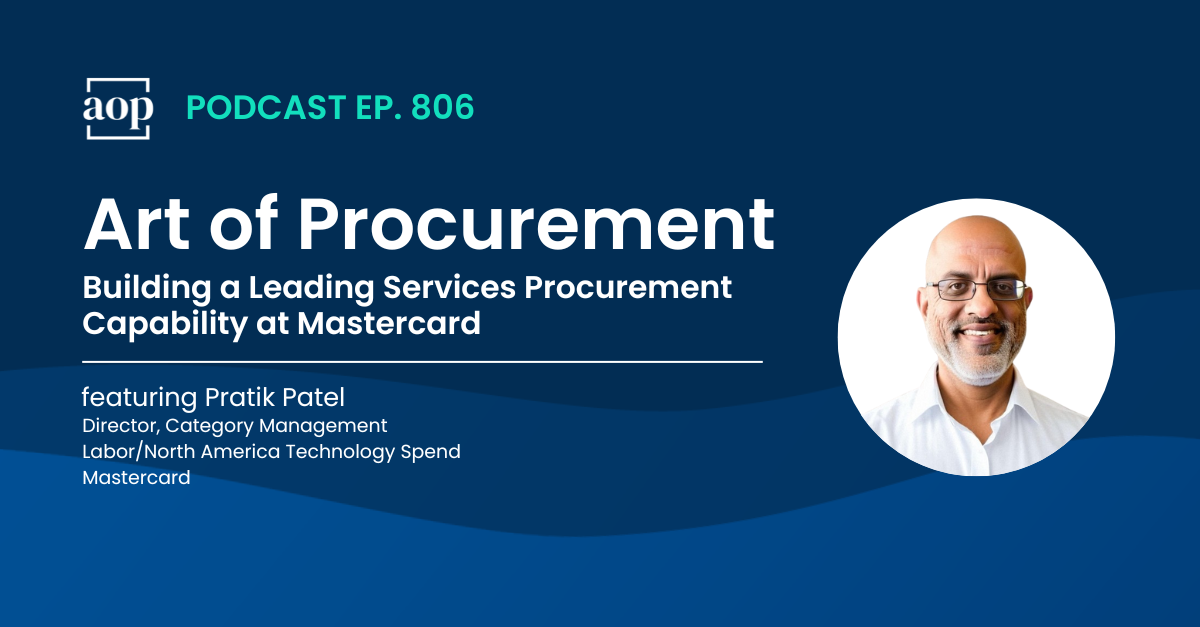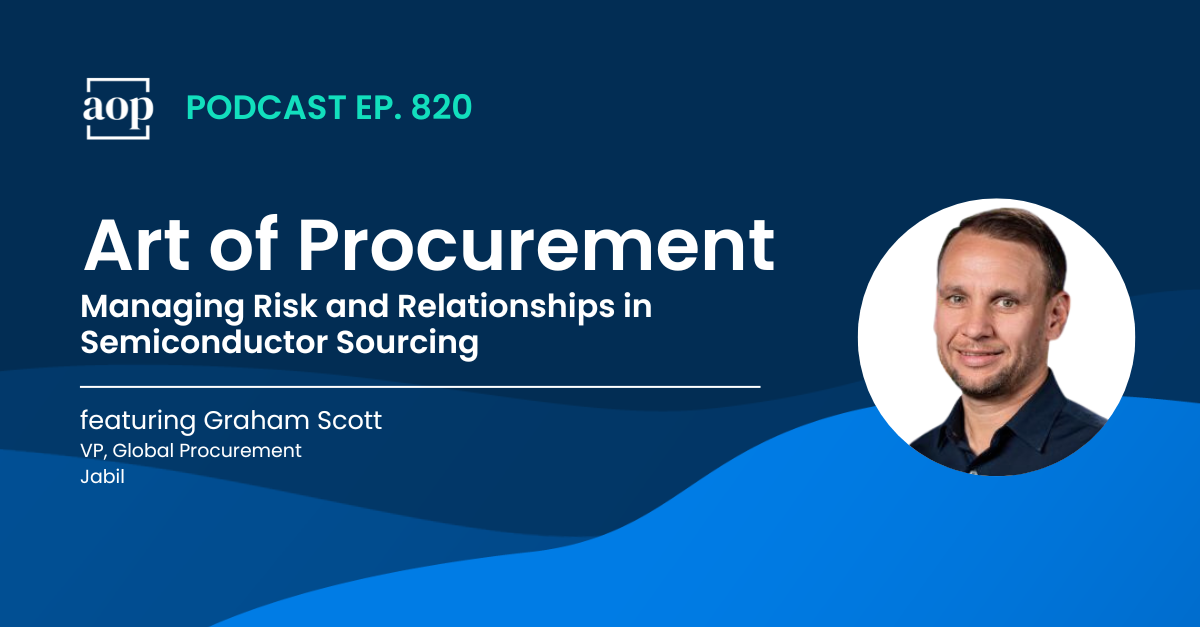
Over the course of the year, the Art of Procurement team is privileged to speak to a LOT of people from across the procurement ecosystem. In 2022, we created almost 200 podcasts, three multi-day events, ran a monthly webinar series, and facilitated a number of roundtables and CPO dinners. I personally traveled to eight procurement and supply chain conferences across North America. We see and hear a lot – the vast majority of it in candid, off-the-record conversations that can never be shared verbatim, but that inform our perspectives and opinions.
Based on these experiences, I want to share three key messages for procurement leaders to consider at the beginning of this new year. These messages are my honest assessment of where the majority of procurement is – not everyone, but the vast majority.
CEOs don’t think about procurement.
There are few other professions that have the opportunity to impact every corner of the business like procurement.
However, there are also few (if any) other professions that are as underrated by the executive suite. This is something we’ve all struggled with at some point in our careers, and as any regular listener will know, it is something I have focused a lot of time on, working to build and articulate a value proposition that compels procurement-business partnership.
An HBR study featured in a podcast last year with the leaders of the BCG procurement practice, found that CEOs only spend 1 percent of their time working with suppliers despite supplier spend representing anywhere from 15-70 percent of total company revenue.
This isn’t news to anyone who has tried to pitch to their CEO on the procurement value proposition. So, why don’t they think about procurement?
I believe it is not because they do not think about their company’s ability to buy the products and services they need, when they need them, at the right price. It is because procurement is an internally facing team; we tend to talk about all the details, in our own language, in a way that isn’t particularly accessible for others.
I would also speculate that for many CEOs, the act of ‘procurement’ is administrative. There isn’t necessarily a connection between ‘procurement’ and strategic buying.
What do CEOs think about? They think about cash flow generation, growth, innovation, risk and business continuity, reputation management, shareholder and stakeholder management, and strategic planning.
Every one of these can be – SHOULD BE – supported or enabled by procurement. But does the CEO know it? Asked another way, has procurement demonstrated that they can support these priorities in a way that is apparent to the CEO?
Procurement needs to think about ourselves and the way we communicate differently or deliver results that get their attention.
Procurement will transform beyond recognition in the next 10 years – or cease to exist.
I hope that you recognize we are not prone to hyperbole at Art of Procurement.
That being said, technology and service provider delivery models are converging in a place where a lot of what we can do can be devolved back into the lines of business, to distributed buyers. This could be a guided buying solution that walks a budget holder through the entire sourcing process or an outsourced third party that manages all of your tail spend where buyers in the business are responsible for determining which buying channel to use.
I believe this will lead to a much smaller procurement organization, with those who remain serving as relationship leads and architects, designing and building highly customized processes and experiences for each stakeholder group, and leveraging a whole raft of technologies and external partners in the process.
The strategic side of procurement will focus on solving challenges or taking advantage of opportunities that drive true competitive advantage – those products and services that your direct competitors also buy.
Those products and suppliers will not be determined by how much money we spend with them. Which poses a question for another day – will new segmentation models be necessary?
This is an opportunity for procurement professionals and organizations that are change-oriented. They will get to shape the future of the profession and will be forever sought after by the C-suites of organizations who are not as far along in the transformation journey. In doing so, we will achieve the ultimate goal of building a value proposition that compels the CEO and the rest of the leadership team to want to partner with procurement to buy more strategically.
The evidence that we see is that most – and I stress most, not all – procurement organizations are not that far along the maturity journey.
I’m a big proponent of the idea of “crossing the chasm”, an idea explained by Geoffrey A. Moore in his book of the same name. His adoption curve is a model that describes the stages through which a new technology or product typically passes as it is adopted by the market.
In this instance, I am thinking about procurement as a product – as a product that is using or experimenting with new technologies, talent models, flexible processes, that are fully embedded into the broader business objectives.
The curve is divided into five stages:
- Innovators: Representing 2.5 percent of the population and labeled as enthusiasts. This is the initial phase of the adoption curve, where a new technology or product is introduced to the market. At this stage, only a small number of innovative individuals or organizations are interested in the new product.
- Early adopters: Representing 13.5 percent of the population and labeled as visionaries. In this phase, the new product begins to gain traction among a larger group of early adopters who are willing to take risks and try out new technologies.
- Early majority: Representing 34 percent of the population and labeled as pragmatists. As the new product becomes more widely accepted and proves its value, it begins to attract a larger group of early majority adopters who are more cautious and tend to wait for others to try out the product before adopting it themselves.
- Late majority: Representing 34 percent of the population and labeled as conservatives. In this phase, the new product is widely accepted and is being adopted by a large portion of the market. However, there is still a significant group of late majority adopters who are hesitant to try out new technologies and only adopt them when they become the norm.
- Laggards: Representing 16 percent of the population and labeled as skeptics. The final phase of the adoption curve is the laggards, the last group to adopt a new technology or product. These individuals or organizations tend to be resistant to change and only adopt new technologies when they have no choice.
The “chasm” is the part of the curve where an idea jumps from one embraced and adopted by enthusiasts and visionaries to the mass market. Once that chasm is crossed, full adoption is only a matter of time.
Based on recent conversations with technology firms, procurement-focused venture capitalists, and leading transformation consultants, procurement is still in the very early innings of transformation – somewhere between the innovator and early adopter stages on Moore’s adoption curve. We are not close to crossing the chasm to mainstream adoption.
What happens when the pace of change is slow and the C-suite doesn’t understand the procurement value proposition?
Procurement leaders that drive this transition at speed are in control of their own destiny, forging a path to greater impact and strategic importance.
Those who accept the status quo will have procurement changed for them by their C-suite. They are not in control of their own destiny.
This dynamic was a primary motivation for me to start Art of Procurement: to provide the inspiration, insights, and how-tos that ensure procurement leaders regain or maintain control of their own destiny so that collectively we have an exciting impactful profession to work in… rather than none at all.
Back in the day, procurement transformation was equal parts people, process, and technology. The best transformations (i.e. continuous improvement programs) are still built on these foundations.
Technology is now the forcing factor that drives procurement transformation. Well-funded technology firms require growth to drive their valuations and their ability to raise additional capital – especially with the tightening of capital markets.
If they aren’t seeing the growth they need, they will place additional focus on selling to the C-suite and bypassing procurement altogether. The ROI calculation may be very different when selling to the CEO or CFO vs. the CPO. We’ve heard recent examples of procurement solution providers skipping the CPO altogether and attempting to sell their services – some of which automate parts or all of the buying process – directly to the CEO, CFO, or COO.
So what can you do about this and put procurement in the driving seat for controlling its own destiny?
Now is the time to think big and take some well-informed risks!!
This is a call to action. Procurement needs to understand the technology landscape, emerging delivery models, etc. and take a position on how to leverage them.
With this information, build a vision for the future. This vision MUST include advanced use of automation and AI and the distribution of tech-enabled buying responsibility back into the business because this is what is being pitched to your C-suite.
Write or revisit your transformation plan. This is relevant if you are a CPO with responsibility across procurement or if you are a category lead. Ensure procurement is aligned with business objectives and considers how it creates a competitive advantage.
It is time to think outside the box and reimagine what procurement can do to support the business. Some teams have been on this journey over the last three turbulent years; for others, the journey has not yet begun.
What are we doing to help in 2023?
Art of Procurement will continue to showcase innovators and early adopters who are taking the lead on transforming procurement and challenge us to think differently. This may inspire you and help you drive change with confidence or it may be a great frame of reference to validate the journey you are already on. Expect to see a lot more content targeted at specific industries to make it even more actionable than ever.
We will continue to provide a window into service providers who can support your change journey and ensure you are as informed about the tech market as possible.
In mid December, we created the AOP Executive Circle, a space for executive level procurement professionals to explore concepts, share ideas, and learn from each other. 75 procurement executives have already signed up. If you didn’t receive an invite and are the CPO, VP / Head of Procurement, or responsible for procurement transformation, email me directly at philip@artofprocurement.com.
We will be building a lot more content to explore the idea of 10X’ing the impact of procurement. This requires a mindset shift to reimagine what is possible, a performance boundary that will differ based on industry and company. We want to facilitate a conversation across the profession to explore this together.
Finally, we are going to continue to look outside the profession to find ways to advocate for procurement outside of procurement and close that CEO awareness gap.
Welcome to 2023 – and what a year it will be – IF you thrive on change, uncertainty, and bringing order to chaos!





